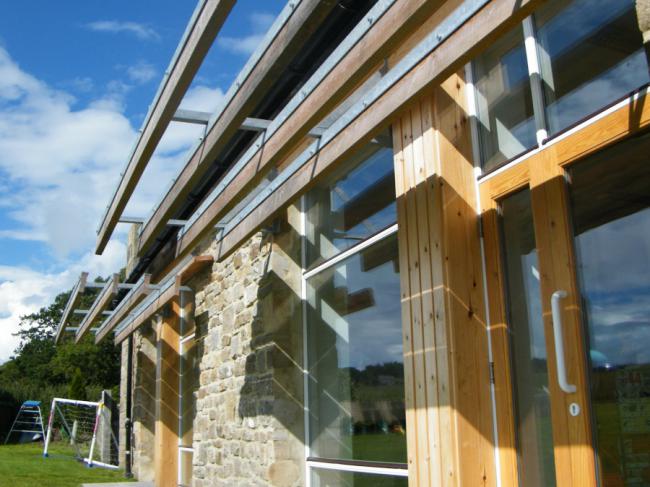Whitfield School
Brief
Whitfield is a small country church first school in Northumberland. Newton architects were commissioned to review the current layout and to produce a scheme to extend, thermally upgrade and research what sustainability measures were available for the very successful yet cramped existing school. The school is made up of two mixed classes with children taught from ages 4 to 9 years. The site is partially sheltered, the buildings to the south do not restrict solar aspect to any extent. It is sheltered by woodland to the north. Further up the hill, to the south there is a good wind regime. Having ensured that the building fabric minimises energy use, what any renewable energy system has to do is hence reduced. The site lends itself to a wind turbine. Generating electricity leads to consideration of a ground source heat pump. A photovoltaic array might be a useful additional part of the system as it generally provides power at times the turbine might not be a full power.
http://www.zerocarbonschool.co.uk/pdf/newtonarchitects.pdf
Design
At Whitfield, it is possible for the important spaces of the school to track the sun and the site is also ideal for wind power, being near the top of a small hill and away from houses.
Carefully sized and positioned glazing is essential to maximise the use of daylight when available. There are well rehearsed strategies for cross ventilation or stack ventilation within the school. The entrances should be on sheltered sides of building and lobbied with unheated spaces, these spaces can contribute to passive solar gain preheat at both ends of heating season.
The reuse of materials is important, for example, the crushed concrete from demolition can be reused for aggregate. Maintenance over the life of the building influences the choice of many materials, but the detailing of construction is critical in minimising some maintenance, for example, overhanging roofs will protect walls.
BRIEF OUTLINE OF PROPOSED ENERGY SYSTEM.
The aim of the system is to be carbon neutral over a year. There are three critical areas that will affect how close to carbon neutral the school can be over a year.
1: The building can be made as airtight as assumed
2: The wind regime is as the data suggests
3: The users are educated to and prepared to operate the building appropriately.
(6kW wind turbine: 9-10000kWh/yr on this site,10kW wind turbine, blade dia 6.2m mast 15m, 16-18000kWh/yr)
GSHP is most efficient when producing warm rather than hot water. Hence it would heat either underfloor pipes or oversized radiators.
Other compatible, renewable technologies:
Rainwater recycling for flushing toilets, at Whitfield this would reduce the demand on the spring water and its resultant treatment.
Details






